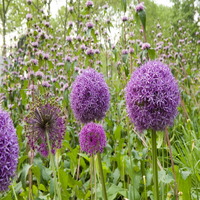Ornamental Onions

You'll know these pretty plants are in the onion family from the mildly pungent odor of their leaves when cut, but they certainly won't bring tears to your eyes! The many species and cultivars of these easy-to-grow plants add color to the flower garden from spring through fall. All have more or less spherical flower heads atop single stems rising from a clump of leaves that are narrow and onion-like in most cases.
About This Plant
All ornamental onions are in the
Allium genus. Many of these, especially the late spring and early summer bloomers, form bulbs that are planted in the fall, just as you would daffodils or tulips. But some of the alliums that bloom later in the season develop a rhizomatous root system and are usually sold in containers along with other perennials. Chives, those standbys of the herb garden, fall into this category. The foliage of the early bloomers lasts only briefly, often disappearing as the plants come into bloom, while the foliage of the alliums that bloom later in the season remains green and attractive much longer. Most are hardy in Zone 4 to 8.
Special Features
Allium aflatunense 'Purple Sensation' Round, 4 to 5 inch wide, violet-purple flower heads rise on 2 to3 foot tall stems in mid to late spring.
Allium 'Globemaster' This is a real showstopper, with silvery purple flower heads as large as volleyballs on 3 foot stems. In bloom for weeks in late spring and early summer, the foliage of these plants usually holds up well during the bloom period.
Allium schubertii (Tumbleweed Onion) If you're looking for something truly different, try this late spring bloomer. Like floral fireworks, the 12 inch wide, rose pink flower heads are composed of individual star-shaped florets, each on a different length stalk, giving the entire head a loose, spidery appearance. Not as hardy as other alliums, it does best in zones 7-9.
Allium sphaerocephalon (Drumstick Allium) The 1 to 2 inch, reddish-purple flower heads of this midsummer bloomer are oval in shape.
Allium senescens subp.glaucum (Corkscrew Onion) Look for this allium in the perennials section of the nursery; it grows from rhizomes rather than forming a bulb. Blooming in mid to late summer with 2 inch lavender-pink flower heads, its distinctive, flat, corkscrewed foliage remains attractive throughout the summer.
Allium triquetum Unlike most alliums, this late spring bloomer does best in part shade and its 2 inch white flowers are nodding, rather than erect.
Allium thunbergii 'Ozawa' (Japanese Onion) One of the last to bloom, the one-inch, rosy pink, globe-shaped flowers top foot-tall stems beginning in September. This rhizomatous allium is usually offered for sale in containers.
Site Selection
Select a site with well-drained soil in full sun, with the exceptions noted above. Place alliums whose foliage deteriorates so that surrounding plantings hide the fading leaves.
Planting Instructions
Plant bulbous kinds in mid fall, covering bulbs with twice their diameter of soil, 3 to 5 inches deep for small bulbs and 6 to 8 inches for large bulbs. Space bulbs from 3-4 inches apart for the smallest to 12 inches for the largest. Set out container-grown alliums anytime during the growing season. Prepare the garden bed by using a garden fork or tiller to loosen the soil to a depth of 12 to 15 inches, then mix in a 2- to 4-inch layer of compost.
Care
Dead head ornamental onions to prevent self-sowing by clipping off the flower stems at their base. Feed bulbous ornamental onions in fall with a surface application of a complete organic fertilizer; even if foliage isn't present, the nutrients will be taken up by the roots, which are actively growing. If your soil is poor, you can make a second light fertilization in spring just as the bulb foliage is emerging. Feed rhizomatous alliums in early spring with a complete organic fertilizer. Apply a thin layer of compost each spring, followed by a 2-inch layer of mulch to retain moisture and control weeds. Water plants during the summer if rainfall is less than 1 inch per week. If flowering falls off, dig up and divide bulbous alliums just as their flowering finishes and foliage ripens. Divide rhizomatous types in early spring.






 You'll know these pretty plants are in the onion family from the mildly pungent odor of their leaves when cut, but they certainly won't bring tears to your eyes! The many species and cultivars of these easy-to-grow plants add color to the flower garden from spring through fall. All have more or less spherical flower heads atop single stems rising from a clump of leaves that are narrow and onion-like in most cases.
You'll know these pretty plants are in the onion family from the mildly pungent odor of their leaves when cut, but they certainly won't bring tears to your eyes! The many species and cultivars of these easy-to-grow plants add color to the flower garden from spring through fall. All have more or less spherical flower heads atop single stems rising from a clump of leaves that are narrow and onion-like in most cases.